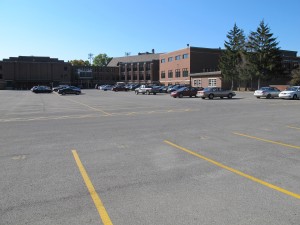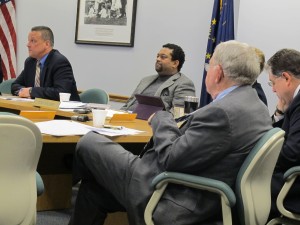Why You Should Care About The Indy Takeover School Funding Fight

Kyle Stokes / StateImpact Indiana
T.C. Howe High School, a public school on the east side of Indianapolis. Charter Schools USA, a Florida-based private school management company, will run the school next year — and the Indiana Board of Education grappled with how to fund it at its Wednesday meeting.
There are State Board of Education meetings and then there are State Board of Education meetings.
Wednesday morning’s session in Indianapolis was the latter.
On paper, members of the executive panel voted to approve a funding mechanism for the four Indianapolis Public Schools slated for state takeover in less than a month.
They did so — with one dissenting vote — over the protestations of IPS representatives, who say the mechanism pays the turnaround operators for students who won’t attend the takeover schools next year. That, they say, hurts the district’s finances.
But in a broader sense, board members had to reconcile conflicts between important tenets of the presently-prevailing school of thought in education policy — tenets, by the way, that affect schools both inside and outside IPS’ boundaries.
On one hand, state board members said schools must be held accountable for poor test scores. On the other, board members said state funding must follow the child. But in this case, the board members ultimately decided they weren’t able to do both.
What’s The Dispute About?
Earlier this year, IPS officials asked all students enrolled in Emma Donnan Middle School and Arlington, Howe, and Manual High Schools to tell the district where they would go to school next year — the takeover school or another school within IPS. As we wrote back in February, more than 40 percent of students decided to remain in the district.
But Indiana Department of Education officials say IPS’ numbers can’t be used to determine the level of state funding for the takeover schools. Those numbers, IDOE Special Education Director Nicole Norvell told the State Board Wednesday, are not what the law defines as “the best available data.”
The “best available data” the state wants to use is older, though. State officials want to use the September 2011 enrollment count.
IPS representatives countered that the law allows the state to use the district’s numbers as a basis for a more accurate estimate of the school’s population next year.
“This is not a number we’ve pulled out of the air,” said Libby Cierzniak, an attorney who represents IPS, in comments before the board Wednesday. She later added, “There’s no precedent for what you’re doing right now.”
(The state is also taking over Gary’s Roosevelt High School. Officials from Gary Community School Corporation were not present at Wednesday’s meeting. State superintendent Tony Bennett also “recused” himself during the hearing.)
Why Should I Care?

Kyle Stokes / StateImpact Indiana File
State superintendent Tony Bennett, left, leads the Indiana State Board of Education meeting on February 8. (Bennett excused himself from the discussion of takeover funding at Wednesday's meeting.)
In the past, schools were funded based on rolling averages — we’ve explained that before (twice). But Indiana lawmakers and education policymakers have set up a system where state school funding is closely tied to the numbers of students a school actually enrolls in a given year.
“I believe very firmly that money should follow children wherever possible,” said board member Neil Pickett, who was the lone dissenting vote against the state’s proposed funding mechanism for IPS. He felt there might be a more “equitable solution” than using old numbers to determine next year’s enrollment in the takeover schools.
But can money follow students even if they choose to go to a district, such as IPS, that’s been sanctioned for poor test scores in some of its schools?
“We’re here because of Public Law 221,” state board member Jo Blacketor said, referring to the state law authorizing the takeover processes in Gary and Indianapolis. “It’s a punitive — it’s a consequence that we’re here. It’s not a gift.”
Even before the IPS funding fight began, the takeover process in Indianapolis has been riddled with other unexpected complications over enrollment figures and course offerings. At Manual High School, there was even a dispute over what to do about historic artifacts in the school.
How state officials handled these situations could set the tone for a takeover of any Indiana school in the future. (At one point, Blacketor asked whether the board’s vote Wednesday would be setting a “precedent.”)
Two Indiana schools face the possibility of state takeover next year. Indianapolis’ John Marshall Community High School and South Bend’s Dickinson Fine Arts Academy both have received five straight F ratings from the state. After six straight F’s, the state can launch an intervention at that school. Those ratings will be released later this summer.
State board member David Shane said he wasn’t inclined to give IPS what he saw as an “exception” in this instance.
“I would rather err,” Shane said, “on the side of giving a startup — a turnaround operator — the ability to have a broader resource base from the beginning.”


